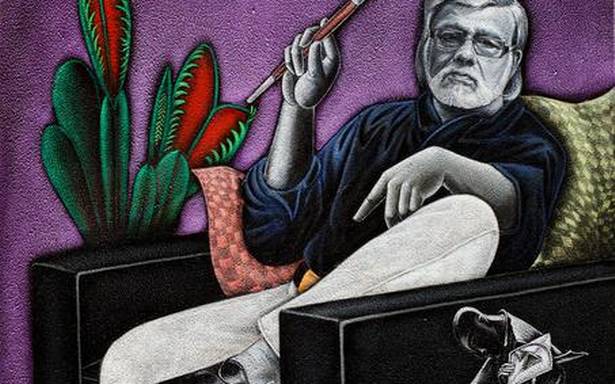On the artist’s 96th birth anniversary, his daughter shares key life lessons and memories
The world knows Satish Gujral (25 December 1925 – 26 March 2020) as the acclaimed muralist, sculptor and architect but to me, he was a truly expressive father. He would hug and kiss his children, his smile telling us that we were his universe. He was the quintessential storyteller too and would never tire of telling stories of life in Mexico (where he trained with the radical Mexican muralist, Diego Rivera), the beauty of Jhelum river, the camaraderie at his art college in Mumbai.
My earliest memory is of him driving his Fiat, with me on his lap. We would be going to my mother’s pottery factory in Okhla where he was working on his famed mural for the Baroda House. Once there, I would be left alone to play with the clay, spin away at the potter’s wheel. We were living then in Tilak Marg in a typical Lutyen Delhi bungalow allocated to him by Prime Minister Jawaharlal Nehru, in recognition of his art. It was a typical sarkari house and my father had converted the garage into his studio. Palettes, rows of easels and many tables decked with murals filled this space. There was also this drum of oil, which became my throne each afternoon. Soon after school, I would rush home, parking myself next to him to observe him work. The deal was that I had to remain quiet, so we spoke with our silence. Mohit and Alpana, my elder siblings, were both away at boarding school and I grew up almost like an only child, my father’s constant companion.
Raseel with her father | Photo Credit: SPECIAL ARRANGEMENT
Our home was a melting pot. where culturally cognizant people of all creative dispositions would meet. From dancer Indrani and her architect husband, Habib Rehman to cultural activist Pupul Jayakar. Modernist Krishen Khanna would be in and out of the house. The art scene was less pocketed and much less competitive. Ideas flowed freely, as did opinions. His contemporaries, who would later be called the Bombay Boys, M F Husain, G R Santosh and SH Raza, would share their journeys with each other. My parents hosted gala parties and were like beacons to free-flowing thinkers. Their home in Pakistan always filled with freedom fighters, poets, authors and activists. Father would be moist-eyed when he recalled how he swam the breadth of the fast-flowing Jhelum river as a child. How his elder brother and former PM of India, I K Gujral, joined their father in the freedom movement. He often spoke of his closeness with painter Frida Kahlo, who became his best friend in Mexico.
Finding Nancy
My biggest art acquisition from his work is also an accidental one. It is called Nancy and is a very muscular, pronounced portrait of his American girlfriend in Mexico who, in reality, was a stunning blonde with blue eyes. I discovered it when sorting the storehouse within the studio and was so enchanted that I told my mother I was hanging it in my bedroom. It was the first interior space I ever designed.
‘Nancy’ | Photo Credit: SPECIAL ARRANGEMENT
That was a much simpler world where artists were truly absorbed in their art, not the fruits of their success. From him I learnt not to allow success to limit my creative flow, which would make me repeatedly go to what ‘worked’. Instead, he asked us to explore, let the mind roam free, disrupt, discover and keep tampering with success. He had an indirect way of influencing all of us through example.
Art as religion
My father was the axis around which our world spun. His work extended to multiple disciplines, and when he turned to architecture, our dining table would have all his architectural models parked on them. While the world marvelled at his projects like the Belgian Embassy or the UNESCO building, I discovered his mastery over scale only recently when I visited Ambedkar Bhavan in Lucknow, a bit bastardised now by the Government’s ghetto style. There was much happening in our house, so many mediums – wood, metal, canvas, burnt wood – being explored. The only religion practised was art and the only way to think was creative.
My parents were one unit and my mother, his bridge to the world. They did everything together and shared this extremely close and also volatile relationship. Right till the end. She would interpret for him at each meeting. He, as we know, had lost his hearing as a child and ASL was not part of the pre-Partition world. Hence his family developed their own means of communicating with him, a vocabulary my mother elaborated further. I call it my father tongue!
(Satish Gujral’s sculptures with burnt wood will be showcased at the India Art Fair 2022 as an ode to the maestro. The family is planning a large retrospective later in the year at the Bikaner House)
Raseel Gujral Ansal is an interior designer and art connoisseur.
Source: Read Full Article


